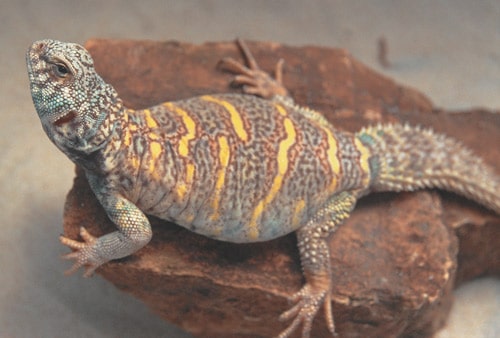One of my uromastyx is losing weight, could this be from fighting?
I’ve had two uromastyx lizards for almost three years. One of them has lost some weight. I recently found a yellow, jellybean-size object inside the cage. I was wondering if that could have been an egg? Lately, the lizards have been fighting. Do they mate at a certain time? Any help would be appreciated.
Do you know the sex of your uromastyx? It sounds as if one is dominant, and the other is submissive. Uromastyx are social lizards and can thrive in a small group. The males are often brightly colored, with females a slightly duller shade.
Fighting can occur when uromastyx are trying to establish dominance, or from a pair attempting to breed. Either way, the one that has lost weight (the subordinate one) should be removed and separated from the aggressor, to allow it to get well, gain weight and no longer be intimidated by the more aggressive one. Feed it well, and keep it warm. The basking area should be about 115 degrees Fahrenheit, with the cool end of the enclosure being in the mid-80’s. At night the temperature can dip into the 70’s. Make sure that you are providing a full-spectrum light with UVB. Feed a mixture of green vegetables, iguana pellets and the occasional cricket or mealworm (dusted with calcium and vitamins). Also offer beans for protein, chopped up to appropriate size.
It does sound like one of your lizards laid an egg (probably the one that has lost weight), but a usual clutch is from 12 to 20 eggs, so there maybe more eggs still to come. I would recommend that you take your uromastyx in to see a qualified herp veterinarian, in order for them to receive a complete check up and evaluation. Radiographs can confirm if one of your lizards is still holding eggs. Also, they can be evaluated for internal parasites (bring in a fresh stool sample from each one, if possible). Do you know if your uromastyx were imported or captive-bred? Imports tend to have more parasite and bacterial problems.
Once you have separated the lizards and beefed up the thinner one, you will most likely be able to put them back together. But before doing so, I would recommend that they get a clean bill of health from your herp vet.
You may also be able to get good information about your two lizards from a local uromastyx breeder, if you have one in the area whom you can consult. A breeder should be able to sex your lizards for you, and a herp vet familiar with uromastyx can also provide you with that information.
If you don’t have a qualified herp vet in your area, try to locate a vet who is willing to see your lizards, and encourage them to utilize the free consultation service provided by the larger veterinary diagnostic labs. Labs that perform herp blood work usually provide a free consultation service for veterinarians using their lab. The vet can call in for a consultation to speak with an experienced herp vet who can provide a wealth of knowledge regarding unusual species. The labs can also provide reference ranges for the blood tests of unusual species. This can be very helpful when dealing with strange species or species that the veterinarian is not familiar with. This way, no vet is without help, and also no pet owner is without the assistance of an experienced herp vet.
Until you can get an appointment with your herp vet, please separate your lizards and feed them well.
Need a Herp Vet?
If you are looking for a herp-knowledgeable veterinarian in your area, a good place to start is by checking the list of members on the Association of Reptilian and Amphibian Veterinarian (ARAV) website at www.arav.com. Look for DVMs who appear to maintain actual veterinary offices that you could contact.
Or, check out the state by state ReptileChannel Vet Listings.



